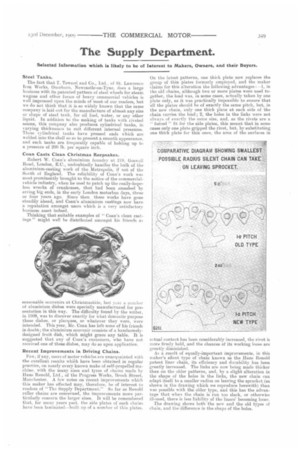The Supply Department.
Page 17

If you've noticed an error in this article please click here to report it so we can fix it.
Selected Information which is likely to be of Interest to Makers, Owners, and their Buyers.
Steel Tanks.
The fact that T. Toward and Co., Ltd., of St. Lawrence Iron Works, Ouseburn, Newcastle-on-Tyne, does a large business with its patented pattern of steel wheels for steam wagons and other forms of heavy commercial vehicles is well impressed upon the minds of most of our readers, but we do not think that it is so widely known that the same company is laid out for the manufacture of almost any size or shape of steel tank, for oil fuel, water, or any other liquid. In addition to the making of tanks with riveted seams, this company also produces cylindrical tanks, in varying thickne.sses to suit different internal pressures. These cylindrical tanks have pressed ends which are welded into the shell so as to present a smooth appearance, and such tanks are frequently capable of holding up to a pressure of 200 lb. per square inch.
Coan Casts Clean Christmas Keepsakes.
Robert W. Coan's aluminium foundry at 219, Coeswell Road, London, E.C., undoubtedly handles the bulk of the aluminium-casting work of the Metropolis, if not of the South of England. The reliability of Coan's work was most prominently brought to the notice of the commercialvehicle industry, when he used to patch up the really-hopeless wrecks of crankcases, that had been smashed by erring big ends, in the early London motorbus days, three or four years ago. Since then these works have gone steadily ahead, and Coan's aluminium castings now have a reputation amongst users which is a very satisfactory business asset indeed.
Thinking that suitable examples of "Coan's clean castings" might well be distributed amongst his friends as
seasonable souvenirs at Christmastide, last year a number of aluminium dishes were specially manufactured for presentation in this way. The difficulty found by the writer, in 1909, was to discover exactly for what domestic purpose these dishes, or placques' or whatever they were, were intended. This year, Mr. Coan has left none of his friends in doubt; the aluminium souvenir consists of a handsomelydesigned fruit dish, which might grace any table. It is suggested that any of Coan's customers, who have not received one of these dishes, may do so upon application.
Recent Improvements in Driving Chains.
Few, if any, users of motor vehicles are unacquainted with the excellent results whieh have been obtained in regular practice, on nearly every known make of self-propelled machine, with the many sizes and tyres of chains made by Hans Renold, Ltd., of the Progress Works, Brook Street, Manchester. A few notes on recent improvements which this maker has effected may, therefore, be of interest to readers of " The Supply Department." Su far as Ronald roller chains are concerned, the improvements more particularly concern the larger sizes. It will be remembered that, for ninny years past, the side plates of such chains have been laminated—built up of a eumber of thin plates.
On the latest patterns, one thick plate now replaces the group of thin plates formerly employed, and the maker claims for this alteration the following advantages : —1, in the old chains, although two or more plates were used together, the load was, in some cases, actually taken by one plate only, as it was practically impossible to ensure that all the plates should he of exactly the same pitch, but, in the new chain, only one thick plate at each side of the chain carries the load; 2, the holes in the links were not always of exactly the some size, and, as the rivets are a " forced " fit for the side plates, this meant that in some cases only one plate gripped the rivet, but, by substituting one thick plate for thin ones, the area of the surfaces in
actual contact has been considerably increased, the rivet is more firmly held, and the chances of its working loose are greatly diminished.
As a result of equally-important improvements, in this maker's silent type of chain known as the Hans Remold patent liner chain, its efficiency and durability has been greatly increased. The links are now being made thicker than on the older patterns, and, by a slight alteration in the shape of the holes in the links, the new chain can adapt itself to a smaller radius on leaving the sprocket (as shown in the drawing which we reproduce herewith) than was possible with the older type, and this has the advantage that whee the chain is run tooI k s_ace, or otherwise ill-used, there is less liability of the liners' becoming loose. The drawing shows both the new and the old types of chain, and the difference in the shape of the holes.




















